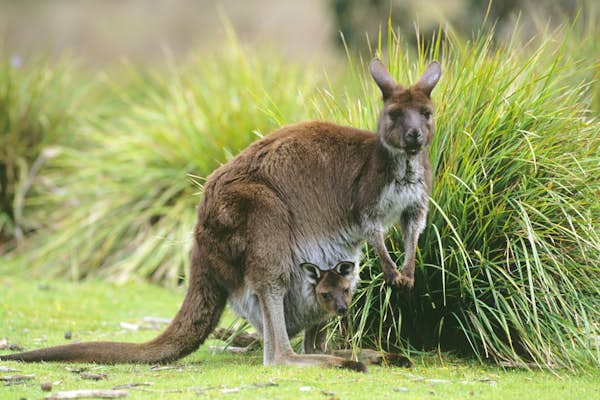The classics are the classics for a reason and this round-up of iconic wildlife encounters is no exception.
Explore Brazil’s wetlands in search of jaguars; search out brilliant bears in Alaska; visit a whole island dedicated to Australia’s national animal; and cruise next to crocs down Botswana’s Okavango Delta.

Head to Kangaroo Island, Australia, for wonderful wildlife at wonderful prices
Lying just eight miles (13 km) off the South Australian mainland, Kangaroo Island hasn’t gone unnoticed. This sizeable outcrop (the country’s third-largest island) is ruggedly handsome and renowned for wildlife – humans play second fiddle to koalas, echidnas, fur seals, sea lions, little penguins and, of course, kangaroos.
Such a reputation attracts tourists and raises prices, especially in peak season. However, a visit in wintry July reduces both, so you can afford to spend longer exploring the beautiful beaches and bushland, with fewer other people. As an extra bonus, this is when you might spot newborn ’roos and wallabies emerging from their mother’s pouches. It’s not even that cold (8-15°C; 46-59°F) – chuck on a jacket and you’ll be right.
- Trip plan: You could do a day-trip, but take advantage of off-season prices to stay for longer. Wildlife hotspots include Seal Bay, Hanson Bay Sanctuary (koalas) and Flinders Chase National Park (kangaroos). Also visit Cape Willoughby’s lighthouse, view the Remarkable Rocks and slurp oysters.
- Need to know: Ferries from Cape Jervis (mainland) to Penneshaw take 45 minutes.
- Other months: Jun-Sep – colder, cheaper, whales; Oct-Nov – spring, flowers; Dec-Feb – hottest, animals retreat into bush; MarMay – warm, calm.

Great wildlife and growing waters make this an ideal time to visit Botswana’s Okavango Delta
Oddly, Botswana’s vast Okavango is wettest when it’s dry. The delta is fed by the Okavango River, which rises far away in Angola’s highlands; the rain falls there at the start of the year and takes six months to trickle down to Botswana’s 5800 sq miles (15,000 sq km) of floodplains, reed-beds, papyrus swamps and vein-like channels – by which time, skies here are cloudless blue.
The waters usually arrive in June, so as July progresses, more of the fingery tributaries become navigable by mokoro (dugout canoe), enabling wonderful water-level wildlife viewing. Guides will punt you past crocs, hippos, waterlilies and birds; animals are drawn to the banks to drink, ensuring excellent sightings. This is peak season, but Botswana’s focus on low-volume, high-value tourism means you’ll still see few other people.
- Trip plan: In the Okavango, consider staying on a private concession rather than Moremi Game Reserve; in the former, night drives and walking safaris are permitted. Combine the Okavango with Chobe National Park (renowned for elephants). Note, lodges can be exquisite, but commensurately expensive.
- Need to know: Mornings can be chilly May to August – take warm clothes for sunrise game drives.
- Other months: Nov-Apr – wet, hot, green season, low prices (Jan: wettest); May-Oct – dry, hot.

Visit Alaska for the best weather and brilliant bears
They say the best things come in small packages, which is true of Alaska’s summer season. The USA’s northernmost state is only fully explorable for a few precious months; to see its unique highlights, you need to visit when the days are long and warm, and the region most accessible.
This is especially true of Denali National Park’s six million acres of wilderness – the one road here is only navigable from early June, and the shuttle buses that open up the majestic backcountry stop running in September. Similarly, viewing the best bear action requires a July or September visit. For instance, July’s a great month to be at Brooks Camp in Katmai National Park, when up to 100 grizzlies stand mid-river to fish for sockeye salmon.
- Trip plan: A two-week trip could include the glaciers, icebergs and whales of Kenai Fjords National Park, wildlife watching and short hikes in Denali, close encounters with grizzlies in Katmai and a ride on the scenic Alaskan Railroad.
- Need to know: Distances are vast. Consider floatplanes/scenic flights to reduce travel time (and get great views).
- Other months: May & Sep-Oct – shoulder months, colder, quieter; Jun-Aug – warmest, busiest; Nov-Apr – snow pursuits, aurora.

For a wet wildlife wonderland in the dry visit Pantanal, Brazil
The Amazon steals all Brazil’s biodiversity headlines, but it’s actually in the country’s Pantanal wetland (which lacks the Amazon’s obstructive jungle) that you’re more likely to spot wildlife. This is especially true during dry season, when foliage is even thinner and creatures gather at shrinking pockets of water.
Animals are abundant here – species include giant otters, giant anteaters, howler monkeys, capybara, caiman, tapir, toucans and hyacinth macaws. Probably most sought is the jaguar. Supporting the world’s highest density of these usually elusive cats, the Pantanal is the best place to spot one, especially June to August, when the deeper wilderness areas are easier to access. Travel at this time and spend a week making excursions from Porto Jofre, at the end of the Transpantaneira highway, and your chances of a jaguar sighting are high.
- Trip plan: In two weeks, use internal flights to combine Rio with a visit to Iguaçu Falls, time at a lodge deep in the Pantanal (making forays by boat, kayak and on foot) and a cruise on the Amazon.
- Need to know: Cuiaba, gateway city to the Northern Pantanal, has an airport.
- Other months: May-Sep – dry; Oct-Apr – wet.
Looking for more inspiration? Check out our book Where To Go When for 360 ultimate escapes from family-friendly adventures to animal encounters and relaxing retreats.
http://shop.lonelyplanet.com/world/where-to-go-when-1/
